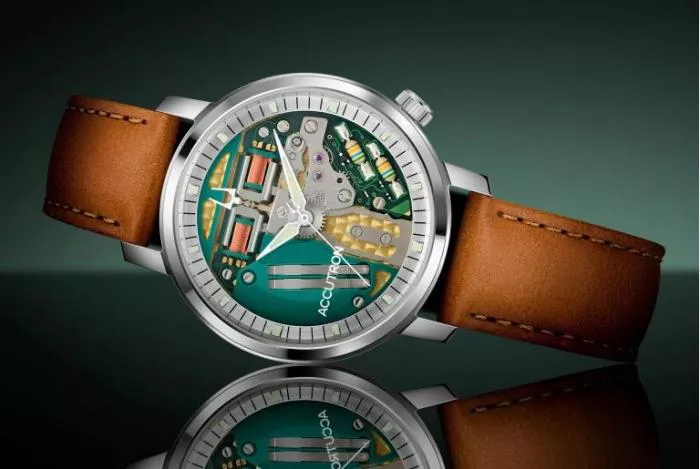Long before Apple, Garmin, Timex, and Casio entered the market, Accutron made history with the world’s first fully electronic watch. In 1960, Bulova’s subsidiary introduced the Spaceview, powered by a revolutionary Tuning Fork movement. Unlike traditional mechanical watches, this mechanism relied on a vibrating tuning fork stimulated by an electric charge, producing a steady 360-hertz frequency.
The movement emitted a distinctive F-sharp hum and offered unparalleled precision, accurate to within two seconds per day. Its high-speed vibration also made it far more resistant to impact than mechanical movements. The smooth, sweeping motion of the second hand set it apart from anything else on the market.
A Technological Marvel That Captivated NASA
Accutron’s Tuning Fork movement was a groundbreaking innovation in horology. Its precision made it invaluable to NASA and engineering organizations during the 1960s. However, the intricate design was labor-intensive and costly to produce.
By 1969, Seiko introduced the first quartz watch, which, while less accurate, was significantly cheaper and easier to manufacture. Quartz technology quickly became the industry standard, and by the mid-1970s, Accutron abandoned the Tuning Fork movement—until now.
The Science Behind the Tuning Fork Movement
Timekeeping relies on a steady, consistent source of repetition. Whether it’s the pendulum of a grandfather clock or the oscillation of atoms in an atomic clock, faster movement translates to greater accuracy—as long as it remains uninterrupted.
The Tuning Fork movement was a brilliant application of this principle. While tuning forks had been used for centuries to regulate large clocks, miniaturizing the concept with an electronic pulse was revolutionary.
Swiss watch engineer Max Hetzel, working under Bulova, devised a system where electromagnetic coils caused twin tuning fork cups to vibrate 360 times per second. A tiny gear with microscopic teeth translated this motion into an imperceptibly smooth sweep of the second hand.
As long as the battery provided power, the movement maintained its remarkable accuracy.
A Faithful Recreation with Modern Touches
Accutron’s new Caliber 314 Tuning Fork movement is nearly identical to the original, though many components remain so delicate that assembly must be done entirely by hand.
The watch’s front closely mirrors the 1960 Spaceview, but the case back has been redesigned. The crown has been relocated from the back to a traditional four o’clock position, and instead of a screw-in battery cover, the movement is now visible through an exhibition case back secured by four screws.
Can the Revival Reignite Accutron’s Legacy?
Since acquiring Bulova (and by extension, Accutron) in 2007, Citizen has made efforts to restore the brand’s prestige. A limited-edition 50th-anniversary Spaceview, built to original specifications, was released in 2010. In 2020, Accutron reintroduced the Spaceview with an Electrostatic movement, though it failed to capture the same magic as the original.
Now, with the revival of the Tuning Fork movement in the Caliber 314, Accutron may finally have the key to reclaiming its former glory. More than 50 years later, its precision and smooth second-hand sweep remain as impressive as ever—proving that some innovations never truly go out of style.


